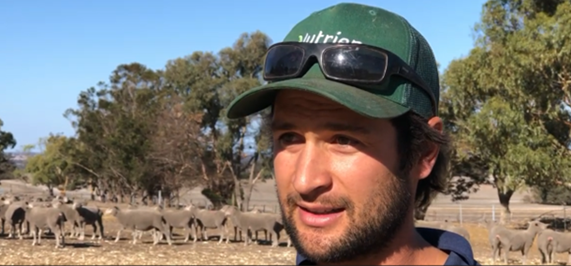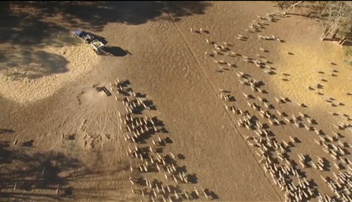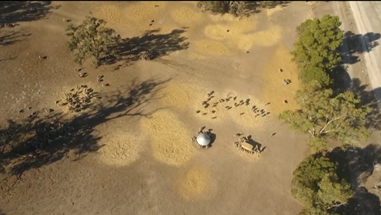Confinement feeding boosts crop area and flock health
05 December 2023
Confinement feeding is where livestock are held in a confined area and supplied feed and water. It is used to defer grazing of paddocks after the break of season rains.
The use of confinement feeding is on the rise in WA and there is strong interest surrounding the topic, with producers keen to learn more and adopt the practice. There is, however, concern about the lack of expertise in implementing the systems. Confinement feeding has many variables including:
- using set pens or small paddocks
- feeding out on the ground or in a trough
- stocking rates and pen sizes
- health management and vaccine programs
- the overall aim of confining.
A Producer Demonstration Site (PDS) project, funded by Meat & Livestock Australia and managed by AgPro Management, commenced in 2022. The PDS ‘Which set up? Implementing confinement feeding’ aims to address these issues and help producers identify why they want to confinement feed and when it should be implemented. This is where Mark Zadow’s experience working out how and when to implement confinement feeding on his property comes in.
Confinement feeding learnings

Mark Zadow is based in Kojonup WA, where he and his family run a mixed cropping and sheep enterprise. The property has a mix of soil types, crops and sheep, with over 2,500 Merino ewes joined to Merinos, and another 1,300 Merinos joined to create cross-bred lambs. With an average annual rainfall of 550mm over the last decade, the Zadows have seen more and more late or false season breaks, more summer rain, and less rain in the growing season. This trend led them to becoming ‘early adopters’ of confinement feeding, compared to the rest of the state. Before adopting confinement feeding, Mark used 20% of his land for cropping, much lower than the average 55% for the district.
“We got into confinement due to pure necessity, with later breaks the last few years forcing us to do something – I guess we were prompted to do it before it was common, as we just didn’t have the stubbles to carry sheep for a majority of the summer/autumn period.
“When we looked at the numbers, since starting confinement feeding, the property has increased its cropping area to 45%, while maintaining its sheep numbers. It’s all due to confinement.
“Growing that early feed means we can stock paddocks well. Confinement supports a higher stocking rate, which has in-turn let us crop more.”
Prior to the project, the Zadows were already using a confinement pen system they had built. They’ve been using it as part of their normal management for over six years. Mark began confinement feeding utilising existing infrastructure, such as pipelines and small paddocks near the sheds and yards. This consisted of setting up multiple pens of roughly 500 square metres, 10m x 50m in size, which held a maximum of 500 sheep each. Included within these were well established trees, with the whole system on a slight slope, with easy vehicle access, and free draining soil. Gravity-fed, three-metre-long troughs provide water to each pen and get cleaned once a week.
“The key is to keep it as simple as possible. Confinement doesn’t have to be a complicated process – just keep feeding them,” Mark said.
The key benefit to confinement is the ability to defer pastures at the break of the season.
“It’s a critical time just before lambing, so the pastures need to be there. It’s that simple,” Mark said.
Ewes leave confinement no later than three or four weeks prior to lambing, with the aim being to achieve over 1,000kg of dry matter on offer in the paddocks, so as to support lambing ewes’ needs.
“Sometimes we reach that point earlier, and the ewes go onto the paddock. Sometimes, it’s right on three weeks prior to lambing, but my deadline is 1 July to get them out,” Mark said.
Depending on the season break, they could spend three to eight weeks in the confinement pens.
“It varies each year. As soon as we get 20 millimetres of rain, they go in, usually in May or April, usually around condition score 3.5,” Mark said.
This year (2023) brought early season rain, followed by a false break and poor rainfall until June. At over nine weeks, it was the longest the Zadows had kept their animals in confinement. Nevertheless, they didn’t see any issues.
“The key is not to let them slip. Maintain that condition and be on the right side of nutrition. It’s one of the reasons we feed oats, lupins and straw – it’s a safe feed ration at high rates so we can’t mess it up.”
The Zadows trail feed in each pen, every second day. This is a lupin and oat mix, with 25% lupins, plus 4kg/hd/wk barley straw.
“It varies on the mob, as we have all our sheep in, but it’s a full confinement ration. The barley straw, our own, gets thrown in once a week. We might as well use it as it’s here and keeps their guts full,” Mark said.
One of their biggest learnings in regards to feed over the last few years was to include calcium salt licks in the pens, especially in the years the sheep remained confined for over three weeks.
“The licks were a game changer in those poor seasons when they had a long time on grain. The other learning was using the autumn drench earlier, to keep worms out of the pens and create clean lambing pastures,” Mark said.
Despite focusing on the way confinement has helped support a higher stocking rate and increased cropping area, Mark pointed out several other benefits they enjoyed.
“Confinement is a great way to monitor flock health and more accurately control nutrition, better matching feed out to pregnant ewes’ demands, there’s huge time savings in feed out and husbandry, such as preg scanning and drenching, as the sheep are so close to the yards. If something goes wrong, you can see it and catch it fast,” Mark said.
Overall, the Zadows admit they still have a lot to learn and could always do better.
It’s all about creating a reliable outcome for your system,” Mark said.
They have indeed done this over the seven years they have refined their setup and worked out how it fits into the overall sheep and crop enterprise.




